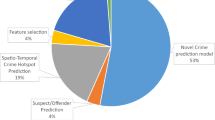Abstract
In the current paper, we propose an approach for the design and implementation of crime detection and criminal identification for Indian cities using data mining techniques. Our approach is divided into six modules, namely—data extraction (DE), data preprocessing (DP), clustering, Google map representation, classification and WEKA® implementation. First module, DE extracts the unstructured crime dataset from various crime Web sources, during the period of 2000–2012. Second module, DP cleans, integrates and reduces the extracted crime data into structured 5,038 crime instances. We represent these instances using 35 predefined crime attributes. Safeguard measures are taken for the crime database accessibility. Rest four modules are useful for crime detection, criminal identification and prediction, and crime verification, respectively. Crime detection is analyzed using k-means clustering, which iteratively generates two crime clusters that are based on similar crime attributes. Google map improves visualization to k-means. Criminal identification and prediction is analyzed using KNN classification. Crime verification of our results is done using WEKA®. WEKA® verifies an accuracy of 93.62 and 93.99 % in the formation of two crime clusters using selected crime attributes. Our approach contributes in the betterment of the society by helping the investigating agencies in crime detection and criminals’ identification, and thus reducing the crime rates.















Similar content being viewed by others
Notes
Jessica Lal murder case, http://www.ndtv.com/topic/jessica-lal Accessed on April 28, 2013.
Nithari case, http://wcd.nic.in/nitharireport.pdf Accessed on April 30, 2013.
Mumbai blast, http://www.ipcs.org/pdf_file/issue/SR71-Final.pdf Accessed on April 28, 2013.
Delhi rape case, http://www.dailymail.co.uk/news/article-2269725/Indian-teenager-accused-Delhi-gang-rape-faces-maximum-year-jail-term.html Accessed on April 28, 2013.
National Crime Records Bureau, http://ncrb.gov.in Accessed on March 10, 2013.
Committee to Protect Journalists, http://www.cpj.org Accessed on March 20, 2013.
Crime alert, http://www.crimealert.org Accessed on March 25, 2013.
NSW bureau of crime statistics and research, http://www.bocsar.nsw.gov.au Accessed on March 22, 2013.
Jin F, Wang W, Xiao Y, Pan Z Proposal of Crime Data Mining Project. https://filebox.vt.edu/users/xykid/dataAnalysisProject/Checkpoint-II_Jin_Xiao_Pan_Wang.pdf. Accessed on May 30, 2013.
Netbeans, http://netbeans.org Accessed on April 2, 2013.
WEKA manual, http://www.inf.ufpr.br/lesoliveira/aprendizado/wekamanual.pdf Accessed on March 15, 2013.
Crime wave in India, http://www.merinews.com/article/the-crime-wave-in-india/132433.shtml Accessed on April 18, 2013.
References
Adderley R, Townsley M, Bond J (2007) Use of data mining techniques to model crime scene investigator performance. Knowl Based Syst 20(2):170–176
Becker RF (2008) Criminal investigation, 3rd edn. Jones and Bartlett Learning Publishers, Burlington, MA
Brantingham PJ, Brantingham PL (1984) Patterns in crime. Macmillan/McGraw-Hill School Division, New York
Chen H, Chung W, Xu JJ, Wang G, Qin Y, Chau M (2004) Crime data mining: a general framework and some examples. Comput IEEE 37(4):50–56
Ehlers D (1998) Predicting crime: a statistical glimpse of the future? Nedbank ISS Crime Index. Halfway House: Inst for Security Stud 2(2)
Gorr W, Harries R (2003) Introduction to crime forecasting. Int J Forecast 19(4):551–555
Gorr W, Olligschlaegerb A, Thompson Y (2003) Short-term forecasting of crime. Int J Forecast 19(4):579–594
Green EJ, Booth CE, Biderman MD (1976) Cluster analysis of burglary M/Os. J Police Sci Adm 4(4):382–388
Han J, Kamber M, Pei J (2012) Data mining: concepts and techniques, 3rd edn. Morgan Kaufmann Publishers Inc, San Francisco, CA
Hornik K, Feinerer I, Kober M, Buchta C (2012) Spherical k-means clustering. J Stat Softw Am Stat Assoc 50(10):1–22
Hussain KZ, Durairaj M, Farzana GRJ (2012) Criminal behavior analysis by using data mining techniques. In: International conference on advances in engineering, science and management, IEEE, pp 656–658
Kaur N, Sahiwal JK, Kaur N (2012) Efficient k-means clustering algorithm using ranking method in data mining. Int J Adv Res Comput Eng Technol (IJARCET) 1(3):85–91
Korukonda AP (2007) Technique without theory or theory from technique? An examination of practical, philosophical and foundational issues in data mining. AI Soc 21(3):347–355
Kulis B, Jordan MI (2011) Revisiting k-means: new algorithms via bayesian nonparametrics. In: 29th International conference machine learning. Omnipress, Edinburgh, pp 513–520
Li X, Juhola M (2014) Country crime analysis using self organizing map, with special regard to demographic factors. AI Soc 29(1): 53–68
Malathi A, Baboo SS (2011) Evolving data mining algorithms on the prevailing crime trend—an intelligent crime prediction model. Int J Sci Eng Res 2(6)
Malathi A, Babboo SS, Anbarasi A (2011) An intelligent analysis of a city crime data using data mining. In: International conference information electronic engineering, vol 6. IACSIT Press, Singapore, pp 130–134
Mande U, Srinivas Y, Murthy JVR (2012a) Feature specific criminal mapping using data mining techniques and generalized gaussian mixture model. Int J Comput Sci Commun Netw 2(3):375–379
Mande U, Srinivas Y, Murthy JVR (2012b) An intelligent analysis of crime data using data mining & auto correlation models. Int J Eng Res Appl (IJERA) 2(4):149–153
Nath SV (2006) Crime pattern detection using data mining. International conference on web intelligence and intelligent agent technology, IEEE/WIC/ACM, pp 41–44
Okonkwo RO, Enem FO (2011) Combating crime and terrorism using data mining techniques. In: 10th International conference IT people centred development, Nigeria Computer Society, Nigeria
Sayal R, Kumar VV (2011) A novel similarity measure for clustering categorical data sets. Int J Comput Apps 17(1):25–30
Siegel D, Bunt H, Zaitch D (2003) Global organized crime: trends and developments. Kluwer, London
Thongtae P, Srisuk S (2008) An analysis of data mining applications in crime domain. In: 8th International conference on computer and information technology workshops (ICCIT), IEEE, pp 122–126
Visher CA, Weisburd D (1998) Identifying what works: recent trends in crime prediction strategies. Crime Law Soc Change 28:223–242
Witten IH, Hall MA, Frank E (2011) Data mining: practical machine learning tools and techniques, 3rd edn. Morgan Kaufmann Publishers, Los Altos, CA
Yu G, Shao S, Luo B (2008) Mining crime data by using new similarity measure. In: 2nd International conference genetic and evolutionary computing (WGEC), IEEE, Washington, USA, pp 389–392
Author information
Authors and Affiliations
Corresponding author
Rights and permissions
About this article
Cite this article
Tayal, D.K., Jain, A., Arora, S. et al. Crime detection and criminal identification in India using data mining techniques. AI & Soc 30, 117–127 (2015). https://doi.org/10.1007/s00146-014-0539-6
Received:
Accepted:
Published:
Issue Date:
DOI: https://doi.org/10.1007/s00146-014-0539-6




